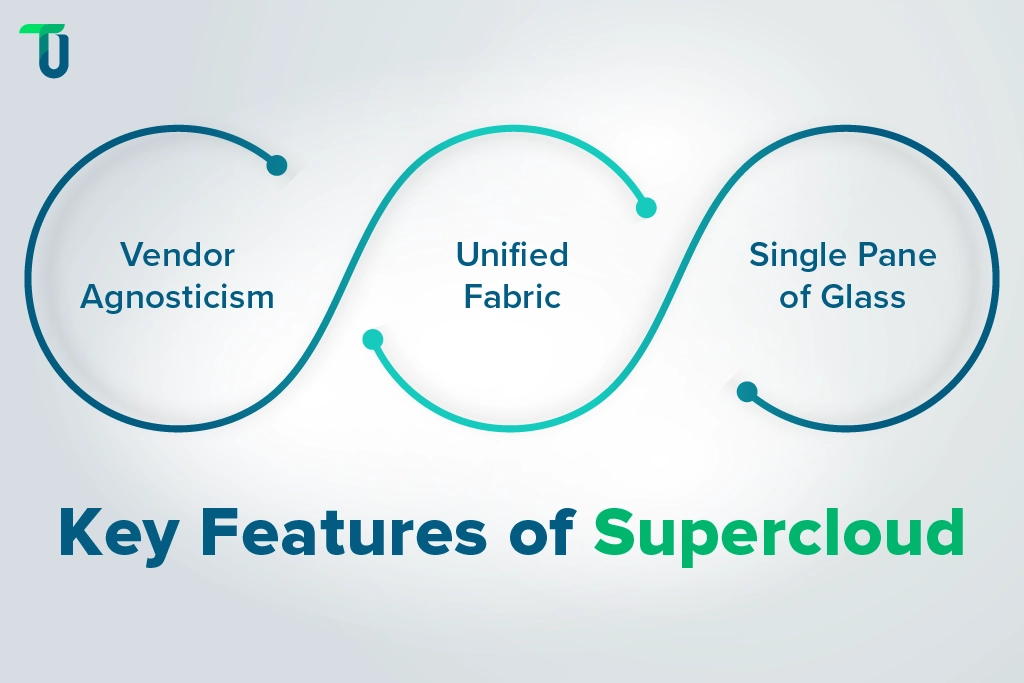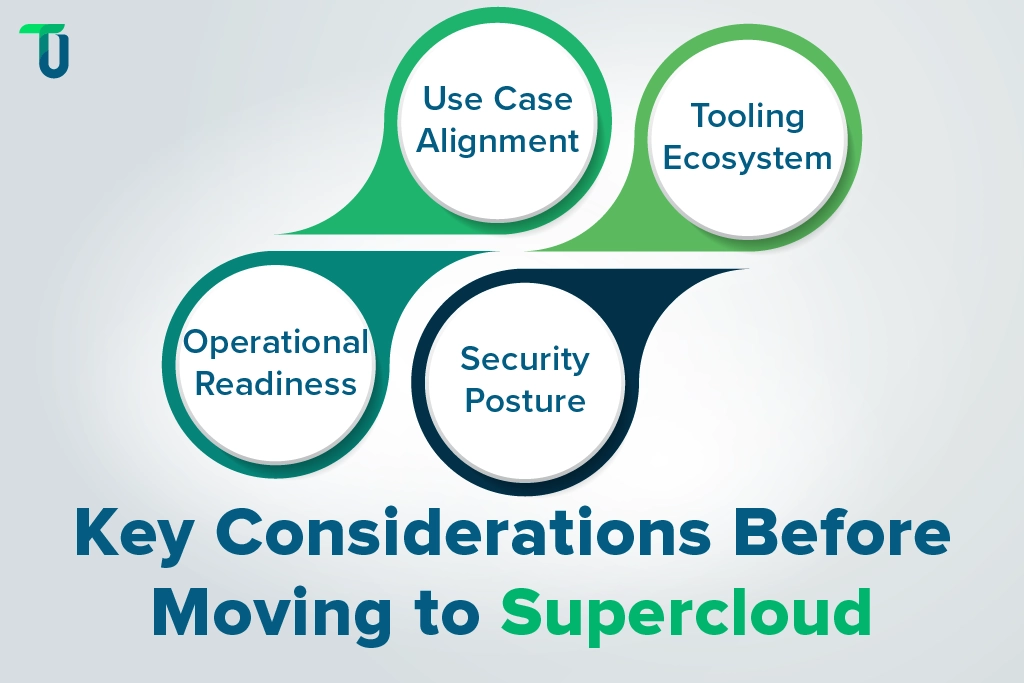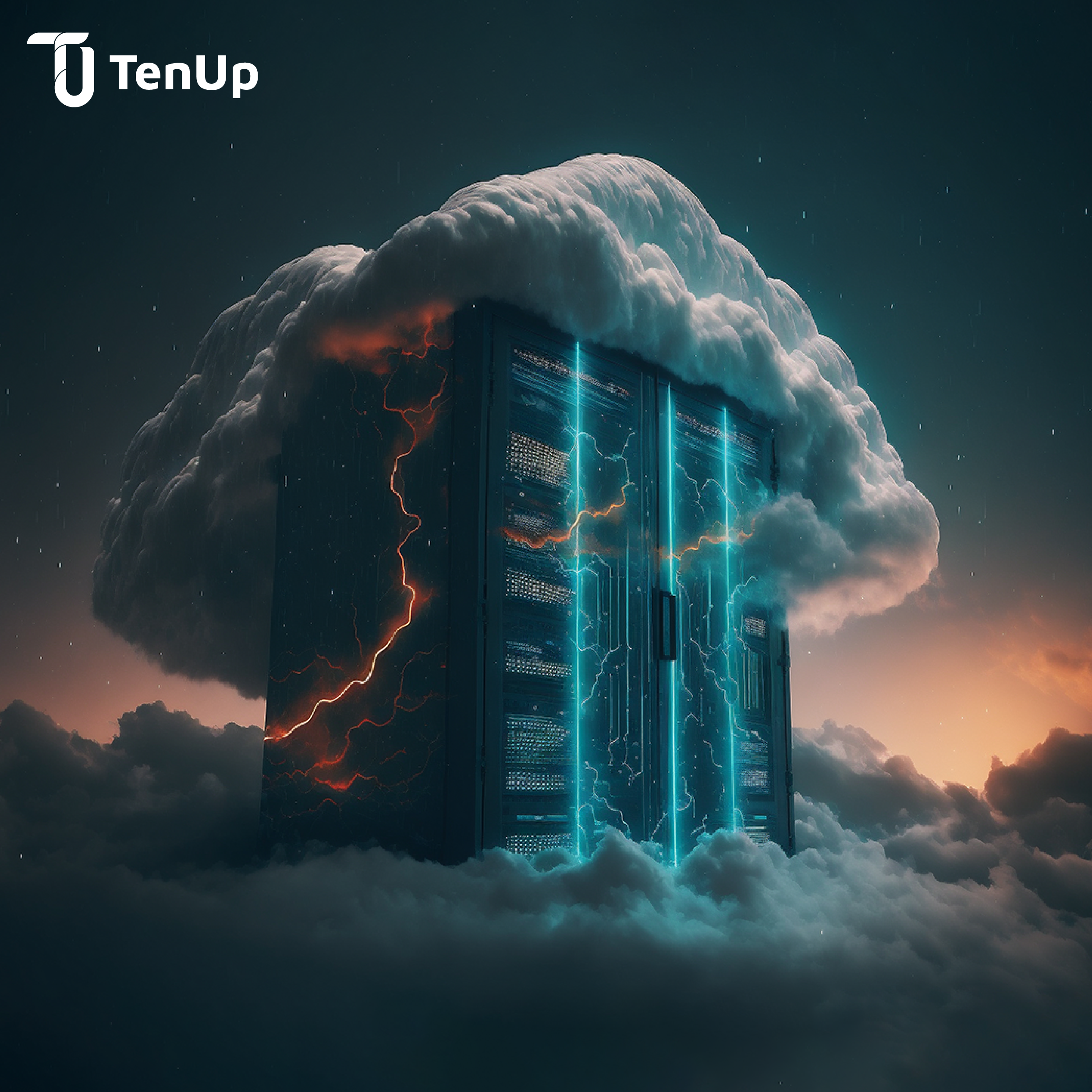Challenges of Multi-Cloud and the Need for Supercloud
While multi-cloud is necessary and has significant advantages, like avoiding vendor lock-in, accessing best-of-breed cloud services, and enabling integration flexibility with multiple business partners, it also introduces challenges around multi-cloud management.
According to Gartner, by 2025, 75% of enterprises will deliberately adopt a multi-cloud strategy, but many will struggle with cloud sprawl, inconsistent security policies, and inefficient orchestration across providers.
The idea of maintaining on-premises data centers simultaneously, migrating to one public cloud, and adding to the redundancy, while stacking two or more additional clouds on top of this cluster, quickly becomes a fragmented infrastructure nightmare. This leads to operational silos, inconsistent cloud automation workflows, visibility issues, and increased costs.
This is where Supercloud steps in as the logical evolution. It acts as a value-added abstraction layer across clouds- public, private, and on-premise, hiding operational complexity, enabling differentiated service capabilities, and supporting the creation of a unified cloud infrastructure that spans across vendors.
Through this cloud abstraction layer, Supercloud solutions streamline orchestration, enforce consistent governance, and enable cross-cloud data platform capabilities that traditional architectures can't support effectively. Get a Custom Supercloud Deployment Plan to see real-world applications. It’s not just a new layer—it's a smarter approach to modern enterprise cloud architecture.
Supercloud: Unified Layer for Cross-Cloud Control
The Supercloud introduces a cloud abstraction layer that breaks down operational silos and barriers between cloud platforms, ushering in a new era of unified cloud infrastructure, vendor neutrality, and cross-cloud orchestration.
As enterprises scale across AWS, Azure, Google Cloud, private clouds, and edge environments, Supercloud solutions act as the connective tissue, delivering centralized cloud automation, governance, and control without compromising performance or agility.
Here’s how Supercloud achieves this:

Vendor Agnosticism
Supercloud helps achieve true vendor agnosticism by abstracting the cloud layer and allowing cloud teams to dynamically select the best-performing, most cost-effective services across providers.
According to IDC, 64% of organizations cite vendor lock-in as a major concern in their cloud strategy. Supercloud directly addresses this issue by making workload portability seamless across cloud environments.
This flexibility enables IT teams to optimize for region, compliance, pricing, and innovation, without re-architecting applications each time they switch providers.
Unified Fabric
Supercloud is not a single centralized cloud but a distributed orchestration layer that spans public, private, hybrid, and on-premise environments. Hence, it delivers a unified cloud fabric that supports consistency in policy, networking, and identity across platforms.
Gartner predicts that by 2027, 40% of enterprise workloads will rely on distributed cloud architectures, highlighting the growing need for cross-cloud unification that Supercloud enables.
This architecture empowers businesses to operate seamlessly across disparate environments, ensuring better resilience, lower latency, and improved workload performance.
Single Pane of Glass
Managing siloed cloud environments is one of the biggest pain points for cloud teams. Supercloud introduces a centralized interface that offers visibility, real-time monitoring, deployment, policy management, and cost tracking.
Did you know that 73% of organizations struggle to get complete visibility into their multi-cloud environments, resulting in inefficiencies, misconfigurations, and compliance risks?
By consolidating management under one control plane, Supercloud reduces complexity, eliminates shadow IT, and enhances decision-making across teams.
Key Use Cases and Real-World Applications of Supercloud
As enterprise IT becomes more complex and decentralized, Supercloud solutions are emerging as the glue that binds multi-cloud, hybrid cloud, and edge computing into a unified cloud infrastructure. With advantages such as real-time processing, ultra-low latency, workload portability, and intelligent orchestration, Superclouds are being deployed across mission-critical sectors to drive innovation and efficiency.
According to Gartner, over 76% of enterprises now operate in multi-cloud environments, making unified control, resource optimization, and automation more crucial than ever.
Let’s explore some high-impact Supercloud use cases across industries:

Finance
High-frequency trading (HFT) demands sub-millisecond latency and adaptive infrastructure. Supercloud enables:
- Rapid compute provisioning across regions
- Latency-aware workload placement
- Real-time risk analytics at the edge
In HFT, even a 1-millisecond advantage can boost profits by up to $100 million per year, making the low-latency capabilities of Supercloud a major competitive asset.
Healthcare
In modern healthcare, data-intensive applications like precision medicine, genomic analytics, and AI-based diagnostics require fast, secure, and compliant cloud access. Supercloud supports:
- HIPAA-compliant cloud orchestration
- Cross-cloud data sharing for collaborative research
- Low-latency diagnostic imaging pipelines
A McKinsey study estimates that AI-driven healthcare can reduce treatment costs by up to $150 billion annually, a shift that Supercloud infrastructure can help enable.
Research & Development
Scientific breakthroughs often rely on simulation and modeling that push computational limits. Supercloud powers:
- Climate modeling, CFD, quantum simulations
- Scalable compute clusters across clouds
- Seamless data movement via cross-cloud data platforms
The U.S. Department of Energy reports that scientific workloads run 40–60% faster on distributed, orchestrated cloud environments—a major win for R&D velocity.
Entertainment & Media
Content platforms demand compute elasticity to deliver real-time personalization, media rendering, and AR/VR experiences. Supercloud offers:
- Auto-scaling for high-traffic streaming events
- Multi-region delivery optimization
- AI/ML-based content personalization
Netflix, for example, uses cloud-native infrastructure to deliver content in over 190 countries—a feat made smoother with cloud automation and orchestration akin to Supercloud.
Smart Cities
Municipal and urban digital initiatives benefit from Supercloud's ability to unify edge, IoT, and cloud data into real-time insights. Supercloud enables:
- Traffic and mobility management with low latency
- Integrated data governance for sensors and public safety
- Energy optimization using AI and predictive modeling
IDC predicts that Smart City tech spending will reach $327 billion by 2026, much of which depends on real-time, unified cloud infrastructure.
Cross-Cloud Optimization
Beyond verticals, one of the most strategic use cases of Supercloud is its ability to unify resources across cloud providers via a single abstraction layer. This:
- Enhances visibility and governance
- Reduces vendor fragmentation
- Prevents cost overruns through dynamic workload placement and cloud automation
59% of organizations overspend on cloud due to a lack of cross-cloud visibility—a problem Supercloud directly solves.
Bonus: For more on how to manage cloud costs efficiently, check out our blog on Proactive Measures to Prevent Overbilling in Cloud-based Services.
Leading Supercloud Solutions and Technologies
As enterprises increasingly shift toward multi-cloud management and hybrid cloud strategy, several vendors are offering platforms that embody Supercloud principles—delivering cloud abstraction layers, cross-cloud orchestration, and unified operational visibility.
According to IDC, over 85% of enterprise IT organizations will commit to multi-cloud architectures by 2026, making robust supercloud tools essential for agility, governance, and scale.
Here are some of the most impactful Supercloud solutions shaping the future of unified cloud infrastructure:
Cisco Metacloud
Cisco Metacloud is a pioneering solution that merges private and public cloud infrastructure using the OpenStack framework. It creates a vendor-agnostic control plane for:
- Managing apps and resources in a centralized interface
- Enabling cloud orchestration across on-prem and public clouds
- Providing policy-driven workload optimization
Ideal for enterprises looking to modernize legacy infrastructure while extending to the cloud without losing control or governance.
VMware Aria (formerly vRealize Suite)
VMware Aria provides full-stack visibility, monitoring, and optimization across AWS, Azure, GCP, and private clouds. Key capabilities include:
- Real-time cost analytics and performance metrics
- Intelligent workload placement with predictive insights
- Compliance-driven governance tools
A Forrester report ranks VMware among the leaders in cloud cost optimization and automation platforms—critical for IT teams managing growing cloud sprawl.
CloudBolt
CloudBolt delivers a unified cloud automation platform that abstracts complexity in hybrid and multi-cloud environments. Core benefits include:
- Centralized provisioning and self-service portals
- Role-based access control (RBAC) for security and compliance
- Seamless resource orchestration across AWS, Azure, GCP, VMware, and more
According to G2 Crowd, CloudBolt users report 30–40% faster deployment times and improved visibility across environments.
Morpheus Data Cloud
Morpheus is a cloud management platform (CMP) designed for DevOps and enterprise IT teams managing hybrid IT estates. It stands out for:
- Unified self-service provisioning
- Lifecycle automation of apps, VMs, and containers
- Built-in cost tracking and policy enforcement
Recognized by Gartner as a strong performer in CMPs, Morpheus supports over 90 integrations across clouds and platforms.
Snowflake Data Cloud
Snowflake isn't just a data warehouse—it's a cross-cloud data platform built to unify data across clouds. It provides:
- Seamless data exchange without replication
- Multi-cloud availability (AWS, Azure, GCP)
- Built-in support for secure data collaboration
Used by 9,000+ customers globally, Snowflake reported $2.8 billion in product revenue for 2024, validating the growing demand for cross-cloud data layers.
Databricks
Built on Apache Spark, Databricks offers a Lakehouse architecture that bridges structured data, unstructured data, and AI workloads—all within a multi-cloud foundation. Features include:
- Native support for ML, AI, and real-time analytics
- Integration with major cloud providers
- Scalable compute with optimized pricing tiers
Enterprises using Databricks see up to 47% faster data science development cycles, according to ESG Research.
Industry Momentum
As cloud ecosystems expand, these Supercloud vendors are pushing the boundaries of what's possible with cross-cloud orchestration and unified governance. Their platforms are enabling a future where organizations can:
- Mix and match services across clouds
- Abstract away infrastructure complexity
- Operate with true vendor agnosticism
IDC forecasts that Supercloud infrastructure investments will exceed $21 billion globally by 2027, fueled by the demand for agility, compliance, and cost-efficiency.
Benefits of Supercloud for Multi-Cloud Management and Unified Cloud Infrastructure
Reduced Complexity with Unified Cloud Infrastructure
Supercloud introduces a cloud abstraction layer that consolidates control of hybrid, public, and private cloud environments into a single management interface—often referred to as a unified cloud infrastructure. This eliminates the operational burden of managing each cloud separately and reduces misconfigurations or redundancy.
82% of enterprises struggle with multi-cloud complexity, making unified orchestration a top priority.
- Centralized visibility and governance
- Intelligent workload placement (cost, compliance, geo-specific needs)
- Avoidance of vendor lock-in
Scalability and Performance Optimization
Supercloud architectures are inherently distributed and designed for low-latency, high-throughput workloads. By integrating compute and storage resources across multiple cloud zones, they offer:
- Global presence and edge computing advantages
- Automatic bursting across clouds to handle spikes
- Consistent performance for distributed applications
Enterprises using distributed cloud platforms have reported up to 35% reduction in latency and 25% faster response times, especially for content delivery and real-time analytics.
Accelerated Innovation and Agility
Supercloud enables a vendor-agnostic approach to application deployment, which means teams can:
- Access the latest AI tools, GPUs, and managed services without platform lock-in
- Build and iterate faster using cloud automation and self-service provisioning
- Allocate engineering resources to innovation instead of infrastructure firefighting
Companies embracing supercloud models report 3x faster development lifecycles compared to single-cloud environments (McKinsey, 2023).
Challenges and Limitations of Implementing Supercloud Across Multi-Cloud Environments
Technical Expertise and Resource Requirements
Deploying and managing supercloud solutions demands advanced skills in:
- Cross-cloud networking
- Security configurations
- Cloud orchestration platforms
Small and mid-sized IT teams may find it challenging to manage the complexity without third-party support or dedicated tooling.
Governance and Policy Enforcement
Managing compliance, data residency, and access control across multiple platforms requires strong cloud governance frameworks. Without unified policies, the risk of data breaches or regulatory violations increases.
According to IBM’s 2024 Cloud Security Index, 45% of cloud misconfigurations stem from inconsistent multi-cloud governance policies.
Immaturity and Market Evolution
Supercloud is still evolving. Some areas, like:
- Interoperability standards
- Cross-cloud billing unification
- Native tool integrations
Enterprises must be cautious of vendor lock-in at the orchestration layer and be selective about platform maturity and roadmap alignment.
Key Strategic Considerations Before Building or Migrating to a Supercloud Architecture
To ensure a successful supercloud strategy, businesses should assess:

- Use Case Alignment: Does your organization benefit from distributed workloads, cross-cloud analytics, or data sovereignty?
- Tooling Ecosystem: Evaluate supercloud platforms like Morpheus, VMware Aria, CloudBolt, and Snowflake for compatibility and extensibility.
- Operational Readiness: Does your IT team have the right skillsets, or will you need to upskill/hire/partner?
- Security Posture: Can you apply consistent identity and access management (IAM), encryption, and monitoring across clouds?
Gartner recommends establishing a Cloud Center of Excellence (CCoE) before embarking on supercloud initiatives to define architecture standards and governance models. To maximize these benefits, organizations often work with an Enterprise-grade Supercloud partner to design, deploy, and optimize their abstraction layers for seamless cross-cloud orchestration.
Final Thoughts: The Future of Supercloud in Multi-Cloud and Hybrid Cloud Computing
As enterprise cloud strategies become more distributed and complex, supercloud architecture emerges as a transformative solution. It’s not about replacing AWS, Azure, or GCP — it’s about orchestrating them through a unified cloud abstraction layer that delivers agility, visibility, and control. Whether driven by regulatory needs, vendor diversification, or performance optimization, multi-cloud adoption is no longer optional — it's strategic.
Supercloud empowers IT teams to harness the best features of each provider, eliminate vendor lock-in, reduce latency, automate governance, and centralize operations — all without compromising on performance or compliance. As tooling matures and abstraction layers become more intelligent, Supercloud will become the default cloud operating model for global enterprises.
Frequently asked questions
What’s the difference between “Supercloud” and hyperscaler-managed clouds?
Supercloud unifies multiple cloud platforms under one control layer for cross-cloud orchestration. Hyperscaler solutions like AWS Outposts extend only that provider’s services, limiting flexibility and increasing vendor lock-in.
Does Supercloud replace hybrid cloud or complement it?
Supercloud complements hybrid clouds by building on its foundation. While hybrid cloud connects public and private environments, Supercloud adds a unified orchestration layer across multiple clouds—including edge—streamlining management, enhancing portability, and improving resource optimization without replacing existing hybrid setups.
Is Supercloud feasible for small or mid-sized companies?
Yes—when used strategically. While Supercloud can be complex, many SMBs are adopting its principles via managed multi-cloud tools to improve resilience and avoid vendor lock-in. With the right support, it offers enterprise-grade flexibility without the overhead. As one CTO put it on Reddit: “It’s not about size—it’s about orchestration clarity.”
Can Supercloud optimize costs better than multi-cloud?
Yes. Supercloud automates workload placement, provisioning, and scaling across providers—factoring in real-time performance and pricing. It reduces data transfer costs and avoids overprovisioning by dynamically choosing the most cost-efficient cloud per task.
Who builds Supercloud platforms—and how mature is the market?
Supercloud platforms are being developed by leaders like AWS, Azure, GCP, Snowflake, and Databricks. While adoption is growing, native Supercloud tools are still early-stage—more layered over existing multi-cloud platforms than fully mature standalone solutions.
What are the technical limitations and challenges of adopting Supercloud?
Supercloud adoption is hindered by cross-cloud networking complexity, lack of orchestration standards, billing fragmentation, and a shortage of engineers skilled in multi-cloud architecture. Interoperability and real-time workload portability remain major hurdles.


